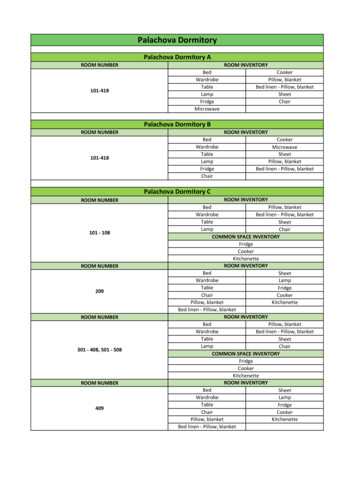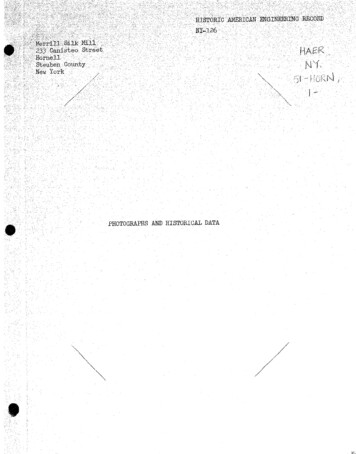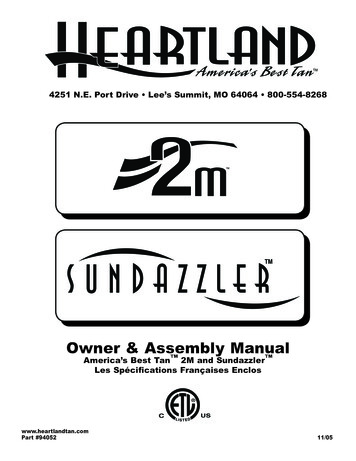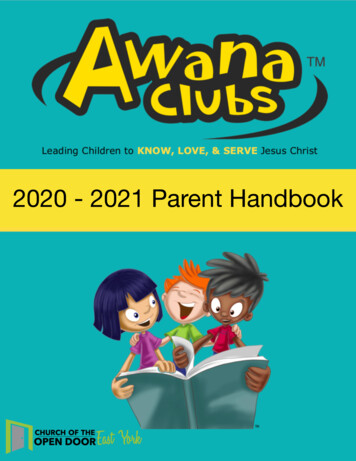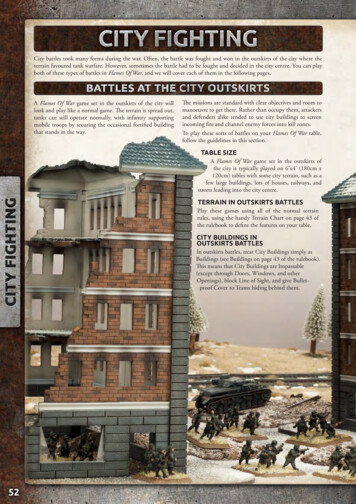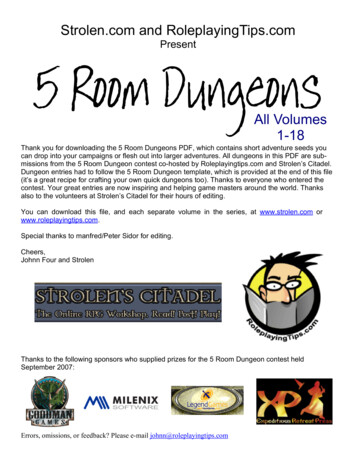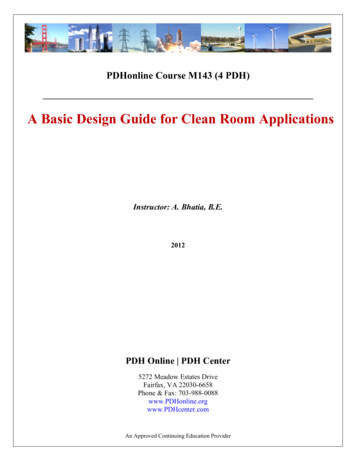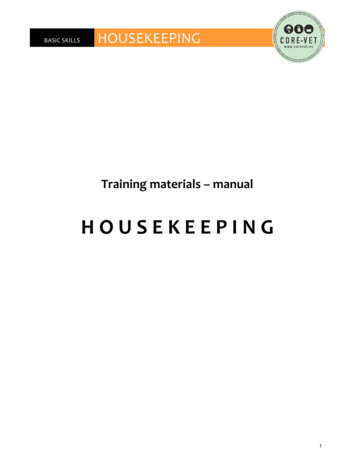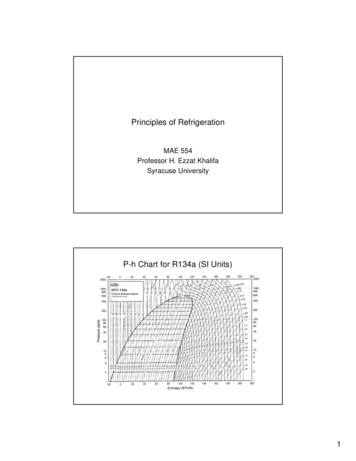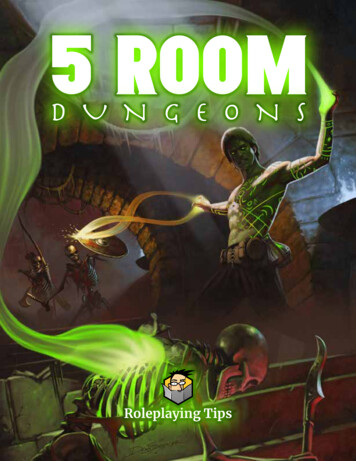
Transcription
5 RoomD U N G E O N SRoleplaying Tips
CreditsThank you for downloading 5 Room Dungeons. It contains 87 short adventure seeds you can dropinto your campaigns or flesh out into larger adventures.All dungeons in this PDF are submissions from the 5 Room Dungeon contest co-hosted byRoleplayingtips.com and Strolen’s Citadel. Dungeon entries had to follow the 5 Room Dungeontemplate, which is provided at the start of this book (it’s a great recipe for crafting your own quickdungeons too).Thanks to everyone who entered the contest. Your great entries are now inspiring and helpinggame masters around the world. Thanks also to the volunteers at Strolen’s Citadel for their hoursof editing.5 Room Dungeons 2019 Roleplaying TipsOriginal Five Room Dungeons Format: Johnn FourCover artwork 2015 Dean Spencer, used with permission. All rights reserved.Internal illustrations from the Very Old School Art Pack:Arthur Rackham, Charles Folkard, Dugald Walker, Edward Burne Jones,Elizabeth Shippen Green, Elmer Boyd Smith, Garth Jones, George Soper, Harry Clarke,Herbert Cole, Howard Pyle, Noel Patton.Other non-attribution stock art has also been used.Layout: Craig JuddEditing: manfred/Peter SidorContest Co-Hosting: Strolen’s CitadelThanks to Roleplaying Tips Game Masters for sharing their boundless creativityand wonderful creations.And special thanks to Roleplaying Tips Patrons who, with their amazing support,are helping GMs around the world have more fun at every game!2
Get More Free Books From Johnn FourNPC Tracker WorkbookNever forget an NPC name or detail again.Please grab my NPC tracker worksheets to help you easilyname, detail, and track every NPC in your campaign.Get Your NPC Tracker Workbook NowCampaign Tracker WorkbookThis simple tool makes running your campaignssmoother.It tracks all your essential details.Print-friendly so you can expand your GM notes asyour campaign grows. Quit losing time to findinglost details.Download Your Campaign Tracker Book3
650 Fantasy City EncounterSeedsHundreds of ideas to get your next city encounterrolling. Rated 5 Stars at DriveThruRPG.Use this book of encounter ideas to inspire yoursession planning.And keep it handy when players surprise you andyou suddenly need a town encounter mid-session.Get Your City Encounter Inspiration Here1,372 Roadside EncounterIdeasHow do you fill the gap between dungeon andtown? This book, drawn from Roleplaying Tipsreaders as part of a contest, gives you instantinspiration for your game’s travels.Stuck for a travel encounter? Not anymore! Justopen this PDF, pick an idea, and roll on.Grab 1,372 Travel Encounter Ideas Now4
ContentsChapter 1:The Five Room Dungeon Recipe. 7An Example Of The Creature Feature For Your5 Room Dungeon Designs. 53Why Like 5 Room Dungeons?. 85 More Adventure Feature Types For YourAdventure Designs. 56The 5 Room Dungeon Format. 10The Subtle Gap You Should Close for BetterStorytelling. 58Chapter 2:Five Room Methods & Advice. 14Chapter 3:The Community Collection of FiveRoom Dungeons.62How To Create Five Room HorrorDungeons. 15Example GM Move With Threats Using Lordof the Rings. 18The Sanctuary of Sumuho. 63A Simple And Fun Way To Run ArmyBattles. 21Crossbones Island. 69Make Your Encounters Intense. 24Foray into the Forest of the Frog King. 79How to Avoid a TPK When GMing IntenseEncounters. 26Diamonds and the Deluge. 83Psssst, How To Tell A Secret. 28Of Pines and Roses. 90Spikes Of Danger Tease Your Players WhileFilling Them With Fear. 32The Tomb of Agellar. 93How To Create Your Own Plot Factory,Part I. 35The Nobleman’s Daughter.103Spawn of the God-Egg. 72Bedizen’s Traveling Dungeon. 86Place of the Embalmers. 97Skanda Biologicals.107How To Create Your Own Plot Factory,Part II. 37The Spirit Never Dies.111Saving Plaque.115How To Create Your Own Plot Factory,Part III. 39Raid on Tantalus IV.118Revenge of the Urn Beast.131How To Create Your Own Plot Factory,Part IV. 41The Mercenary Shrine.136The Elvis Hook For PCs. 43The Cursed Keep of the Wastelands.142How To GM Genius NPCs. 45Lord and Killer.148A Quick Tip On Session Prep. 49Upshi Rises.150Use The Feature Method To Make AdventureDesign A Whole Lot Easier. 51The Wizard’s Challenge.153St. Nathanial - Harbinger of Doom.1585
Drop of Blood in the Bucket.161Heart of the Dwarves.237The Towers of Wisdom.164Orcish Olympics.239The Sledge.167Dragon’s Lair.241A Visit to the Witch’s Cottage.171The Sunken Vault.243Isles of Ice.173Warts and All.247The Tomb of the Dragon Queen.175The Haunting.250The Living Vault.177Pitfall Castle.253Temple of the Volcano God.180Temple of the Four Elements.255The Necromancer’s Cave.182Caravan of Courage.257Merchant’s Crypt.185Prison Break.259The Temple Defiled.188The Company.261The Quest for the Rod of Spellius.190Random 5 Rooms Dungeon Generator.263The Plague Devil.192Promised Aid.265Swamp Music.195Escape From Slavers’ Isle.267Troll Brothers Cove.197The Message.270Deserted Island.198Vault of the Wiglord.272Henge of Ascension.199Catching the Traitor.275Villainous Cellar Pub.200The Windspire.277Ye Classic Wizard’s House.203The Wizard’s Land.280Black Fire Ruins.205The Pyramid.283Shadow Vault.207The Pool of Unmaking.285Thieves’ Guild.210The Masters of Evil.287‘Ringed’.212Retreat.295Tomb of a cleric.214Tomb of the Colossus.296Taking Sides.216Too Many in the Tomb.298Barrow of the Bored Berserker.218Minaret of the Smoking Tankard.301The Stone Labyrinth.221The Witchwood.303Sewer Lair.223Through the Maze.307Stranger Than Fiction.225The Tomb of Three Brothers.309The Well.227The Wizard’s Retreat.311The Governor’s House.229The Shifter.313Blind Pack.231The Braun Castle.315Aboleth.233Next Step:Master Your Dungeoncraft. 317The Great Gate.2356
Chapter 1:The Five RoomDungeon Recipe
Why Like 5 Room Dungeons?This format, or creation method, has several advantages:Any LocationThough I call them 5 Room Dungeons, they apply to any location with five or so areas. They don’thave to be fantasy or dungeons. They could take the form of a small space craft, a floor in a businesstower, a wing of a mansion, a camp site, a neighbourhood.ShortMany players dislike long dungeon crawls, and ADD GMs like to switch environments up often. Inaddition, some players dislike dungeons all together, but will go along with the play if they knowit’s just a short romp. This helps ease conflicts between play styles and desires.Quick to PlanWith just five rooms to configure, design is manageable and fast. Next time you are killing time,whip out your notepad and write down ideas for themes, locations, and rooms. Knock off as manydesigns as you can and choose the best to flesh out when you have more time and to GM nextsession.Easier to PolishLarge designs often take so long to complete that game night arrives before you can return tothe beginning and do one or more rounds of tweaking and polishing. The design speed of 5 RoomDungeons leaves room most of the time to iterate.Easy to Move5 Room Dungeons can squeeze into many places larger locations and designs can’t. If your dungeongoes unused or if you want to pick it up and drop it on a new path the PCs take, it’s often easierto do than when wielding a larger crawl.Flexible SizeThey are called 5 Room Dungeons, but this is just a guideline. Feel free to make 3-area locationsor 10-cave complexes. The idea works for any small, self-contained area.8
Easy to IntegrateA two to four-hour dungeon romp quickens flagging campaign and session pacing, and can besqueezed into almost any story thread. It also grants a quick success (or failure) to keep the playersengaged. The format is also easy to drop into most settings with minimal consistency issues.9
The 5 Room Dungeon FormatRoom One: Entrance And GuardianThere needs to be a reason why your dungeon hasn’t been plundered before or why the PCs are theheroes for the job. A guardian or challenge at the entrance is a good justification why the locationremains intact. Also, a guardian sets up early action to capture player interest and energize asession.Room One challenge ideas:The entrance is trapped.The entrance is cleverly hidden.The entrance requires a special key, such as a ceremony, command word, or physical object.The guardian was deliberately placed to keep intruders out. Examples: a golem, robot, or electricfence.The guardian is not indigenous to the dungeon and is a tough creature or force who’s made itslair in room one.The entrance is hazardous and requires special skills and equipment to bypass. For example:radiation leaks, security clearance, wall of fire.Room One is also your opportunity to establish mood and theme to your dungeon, so dress it upwith care.Room Two: Puzzle Or Roleplaying ChallengeThe PCs are victorious over the challenge of the first room and are now presented with a trialthat cannot be solved with steel. This keeps problem solvers in your group happy and breaks theaction up for good pacing.Make Room Two a puzzle, skill-based, or roleplaying encounter, if possible. Room Two should shinethe limelight on different PCs than Room One, change gameplay up, and offer variety betweenthe challenge at the entrance and the challenge at the end.Note, if Room One was this type of encounter, then feel free to make Room Two combat-oriented.Room Two should allow for multiple solutions to prevent the game from stalling.Room Two ideas:Magic puzzle, such as a chessboard tile floor with special squares.10
An AI blocks access to the rest of the complex and must be befriended, not fought.A buzzer panel for all the apartments, but the person the PCs are looking for has listed themselvesunder a different name, which can be figured out through previous clues you’ve dropped.A concierge at the front desk must be bluffed or coerced without him raising the alarm.A dirt floor crawls with poisonous snakes that will slither out of the way to avoid open flame. (Afew might follow at a distance and strike later.)The PCs must convince a bouncer to let them in without confiscating their weapons.Once you’ve figured out what Room Two is, try to plant one or more clues in Room One aboutpotential solutions.This ties the adventure together a little tighter, will delight the problem solvers, and can be aback-up for you if the players get stuck.Room Three: Trick or SetbackThe purpose of this room is to build tension. Do this using a trick, trap, or setback. For example,after defeating a tough monster, and players think they’ve finally found the treasure and achievedtheir goal, they learn they’ve been tricked and the room is a false crypt.Depending on your game system, use this room to cater to any player or character types not yetserved by the first two areas. Alternatively, give your group a double-dose of gameplay that theyenjoy the most, such as more combat or roleplaying.Room Three ideas:The PCs rescue several prisoners or hostages. However, the victims might be enemies in disguise,are booby-trapped, or create a dilemma as they plead to be escorted back to safety immediately.A collapsed structure blocks part of the area. The debris is dangerous and blocks nothing ofimportance, another trap, or a new threat.Contains a one-way exit (the PCs must return and deal with Rooms One and Two again). i.e.Teleport trap, one-way door, 2000 foot water slide trap.The PCs finally find the artifact required to defeat the villain, but the artifact is broken, cursed, orhas parts missing, and clues reveal a solution lies ahead.Believing the object of the quest now lays within easy reach, an NPC companion turns traitor andbetrays the PCs.Another potential payoff for Room Three is to weaken the PCs as build-up to a dramatic strugglein Room Four.11
It might contain a tough combat encounter, take down a key defense, exhaust an importantresource, or make the party susceptible to a certain type of attack.For example, if Room Four contains a mummy whose secret weakness is fire, then make RoomThree a troll lair (or another creature susceptible to fire) so the PCs might be tempted to burn offa lot of their fire magic, oil, and other flammable resources. This would turn a plain old troll battleinto a gotcha once the PCs hit Room Four and realize they are out of fire resources.Don’t forget to dress Room Three up with your theme elements.Room Four: Climax, Big Battle or ConflictThis room is The Big Show. It’s the final combat or conflict encounter of the dungeon. Use all thetactics you can summon to make this encounter memorable and entertaining.As always, generate interesting terrain that will impact the battle.Start or end with roleplay. Maybe the bad guy needs to stall for time to let PC buffs wear out, to waitfor help to arrive, or to stir himself into a rage. Perhaps the combat ends with the bad guy bleedingto death and a few short words can be exchanged, or there are helpless minions or prisoners toroleplay with once the threat is dealt with.Room Four ideas:Give the bad guy unexpected powers, abilities, or equipment.Previous rooms might contain warning signals or an alarm, so the bad guy has had time to prepare.The bay guys try to settle things in an unusual way, such as through a wager or a duel.The lair is trapped. The bad guy knows what or where to avoid, or can set off the traps at opportunemoments.The bad guy reveals The Big Reward and threatens to break it or put it out of the PCs’ so reach sothey’ll never collect it.The bad guy has a secret weakness that the PCs figure out how to exploit.A variety of PC skills and talents are required to successfully complete the encounter.Room Five: Reward, Revelation, Plot TwistHere’s your opportunity to change the players’ bragging to “we came, we saw, we slipped on abanana peel.”Room Five doesn’t always represent a complication or point of failure for the PCs, but it can. RoomFive doesn’t always need to be a physical location either - it can be a twist revealed in Room Four.12
Room Five is where your creativity can shine and is often what will make the dungeon differentand memorable from the other crawls in your campaigns.In addition, if you haven’t supplied the reward yet for conquering the dungeon, here is a goodplace to put the object of the quest, chests of loot, or the valuable information the PCs need tosave the kingdom.As accounting tasks take over from recent, thrilling, combat tasks, this would also be a good timeto make a campaign or world revelation, or a plot twist.Perhaps the location of the next 5 Room Dungeon is uncovered, along with sufficient motivationto accept the quest.Maybe the identity of the bad guy is revealed. New clues and information pertaining to a major plotarc might be embedded in the treasure, perhaps sewn into a valuable carpet, drawn in painting,or written on a slip of paper stuffed into a scroll tube or encoded on a data chip.Room Five ideas:Another guardian awaits in the treasure container.A trap that resurrects or renews the challenge from Room Four.Bonus treasure is discovered that leads to another adventure, such as a piece of a magic item ora map fragment.A rival enters and tries to steal the reward while the PCs are weakened after the big challenge ofRoom Four.The object of the quest/final reward isn’t what it seems or has a complication. i.e. The kidnappedking doesn’t want to return.The quest was a trick. By killing the dungeon’s bad guy, the PCs have helped the campaign villainor a rival. Perhaps the bad guy was a good guy under a curse, transformed, or placed into difficultcircumstances.The bad guy turns out to be a PC’s father.The true, gruesome meaning behind a national holiday is discovered.The source of an alien race’s hostility towards others is uncovered, transforming them from villainsto sympathetic characters in the story.The true meaning of the prophecy or poem that lead the PCs to the dungeon is finally understood,and it’s not what the PCs thought.13
Chapter 2:Five RoomMethods &Advice
How To Create Five Room HorrorDungeonsRoleplaying Tips Patron Jeffrey asks how to create five room horror adventures:Johnn, been reading for a long time, and always figured that I would one day have a questionworthy of asking. I guess that day is today. How would you use a five-room dungeon to run ahorror game?For readers new to this GMing tool, a Five Room Dungeon consists of: Room 1: Entrance And Guardian Room 2: Puzzle Or Roleplaying Challenge Room 3: Red Herring Room 4: Climax, Big Battle Or Conflict Room 5: Plot TwistYou can use this model to create any kind of adventure, not just dungeons: wilderness, city,roleplay, mystery, and so on. You can also connect 5RDs into larger adventures and vary roomcounts to avoid predictability.To answer Jeffrey’s question, I’m going to throw something new at you:The GM’s Mental DungeonUnlike other genres, horror must curdle our minds. We must prepare a mental game in additionto the physical for horror’s best effects to play out.To do this, you want to layer five themes on top of your plot, encounters, and game elements.These five themes have a rough sequence. Turn this sequence into a five room dungeon in yourmind to help you GM the horror adventure:Mystery: Entrance And GuardianForeshadowing: Puzzle Or Roleplaying ChallengeSuspense: Red HerringFear: Climax, Big Battle Or ConflictSurprise: Plot Twist15
MysteryHorror must involve the unknown. Let fog of war seep over plot elements to create uncertaintyand doubt in your players.For example, monster design. Put your standard orcs into a cult. Have them worship a special orcthat has grotesque characteristics. Make the orc leader a potent foe in some way. Give the culthorrific rituals.Now drop evidence of the cult into your adventure. Mutilated animals. Strange symbols. Whispersof a massive horned creature prowling the woods at night. Guards sent to investigate discoveredbutchered with seeming ease.No clue above reveals facts to give players clarity or confidence. The fog of war drives players’imaginations into dark corners.ForeshadowingWhat creeps into play during the first half of your adventure should come back to claw the PCsin the second.Perhaps a pig roasting over the party’s campfire comes to life and attacks. Its spitted andburning body slams into the PCs until the beast’s last hit point gets carved away. Then later inthe adventure the PCs encounter orc cultists who set their pierced bodies on fire before they attack.Maybe a PC has a fear of drowning. The party might stumble upon rotting animals the druid saysdied by drowning even though the lake is miles away. Then, as the characters penetrate deep intothe forest they encounter water spirits fleeing fire orc cultists and the spirits try to “inhabit” thecharacters for safety.SuspenseDraw the drama out with white-knuckle uncertainty in a gloomy background of threat.Here’s where your mystery and foreshadowing pay off.Sure the PCs might have plate armour, fireballs, and elite survival skills, but the cultists lurk deepin the forest’s heart, numbers and powers unknown.And the mysterious cult leader is some kind of demon or dragon or spirit whose cunning worrieseven the brilliant wizard.Each encounter draws the party closer to their horrible enemy yet provides no assurances aboutwho or what they face.Alone. In the forest. Weaknesses and worries being preyed upon as you pull on player and charactertriggers while they crawl your mental GM dungeon of horror.16
FearNow we come to the goal of horror. The best response we can ask for from our design andstorytelling is fear. This forms the climax you’ve been building toward with mystery (what’shappening and will it hurt me?), foreshadowing (it’s gonna get ya in the worst way possible),and suspense (it could strike at any time!).Fear needs empathy. If one player becomes scared, others will follow. If you can make one gameelement scary, it becomes easier to conjure future fearful NPCs, locations, and situations.Look at the Monster Manual. Orcs aren’t scary. We might worry they could kill us. But that’sstandard gaming fare.However, if we cloak our orcs in obscene cult activities, that threaten PCs not just physically(“The cleric can heal my hit points but am I going to drown today?”), with identities and powersunknown on home turf, we may see the seeds of fear reflected in stressed faces around the table.And then it grows.SurpriseCatch players off-guard and we crack open the gates in invitation to fear. Crumble the wall ofconfidence so doubt and anxiety ooze through the cracks as harbingers that players no longerhave control.Lunge from the shadows you’ve formed to surprise the players. Give false security and take it away.Make what players think they know horribly wrong. And change the ordinary without warning.Layer Your Mental Dungeon Onto The PhysicalNow that we’ve explored the five key psychological aspects of horror, we look for every opportunityto add them to our adventure design.Use the Mental Five Room Dungeon as a rough playbook while you GM:Mystery Foreshadowing Suspense Fear SurpriseDraw these out over the course of a single encounter or several.Repeat several times if possible to create cycles of horror in your adventure.Set the table so your players experience uncertainty, trepidation, worry, fear, and surprise overand over.17
Example GM Move With Threats UsingLord of the RingsLast week I discussed the idea of combining cool boardgame mechanics with adventure design to create1-3 special GM Moves for your 5 Room Dungeons.Roleplaying Tips GM Aidan Hernandez wrote back with a great example using Lord of the Rings:***Hello there,This will be my first time ever responding to a newsletter. However, I felt it important to do sobecause I wanted to show how Creating a Special GM Move can be applied and how you can useit to recreate the mechanics from the narrative.When I read your idea of Effect Feedback Mechanism Counteraction I immediately wasreminded of the Dungeon World/Apocalypse World system known as “Threats.”[Johnn: Here’s a small PDF from the AW site that tells more about Threats.]The Clock adds specific ways I could show an Effect growing stronger or weaker.So I combined the systems to create a dungeon level Threat with specific mechanics. I took fromliterature and reverse-engineered the narrative to become mechanics.So I present my dungeon “The Mines of Moria” inspired by Peter Jackson’s Film The Lord of theRings: The Fellowship of the Ring.Goal (why is this dungeon here): Shortcut, Passage. (It serves as a way through the mountainsfor the Fellowship and a way to avoid going all the way South or near Isengard.)Hazards: Delay, Death. (The mechanics to be used in this dungeon either delay the party and seekto advance The Clock or to Kill the Party and end the Campaign.)Danger: Durin’s Bane aka The Balrog. (The Danger is much like your 4th room Giant. Only itdoesn’t just passively reside in a room physically but acts as the room itself.)Clock: Echoes in the Deep. Each time the Players make a “Loud Noise” the clock advances. (Nowhere I feel the Loud Noise would be the trigger for the roll. Does the Cave Troll falling in battlecounts as a Loud Noise? What about the Kraken at the Entrance? I feel we determine whether ornot the Loud Noise effect occurs from the dice and the clock advancing adds more of these checks.)Clock 0-3: The Silent Halls. Players have not activated any Hazards or the Danger and have littleresistance making their way through the dungeon.18
Clock 3-6: An Echo, Ripples. Players have activated Hazards but not yet the Danger. Hazards nowactively seek to Delay the party or cause Death to the party.Clock 6-9: Shadows of the Deep. Players have activated Hazards and the Danger stirs. (This is myleast defined one since in this scenario the party quickly passes this section.)Clock 9-10: The Echoes Ring. Players have activated the Danger and it now actively seeks them.Hazards now seek to Delay the party to give the Danger time to appear.Clock 10-11: The Drums Beat. The effects of the Hazards grow worse as the Danger draws near.Clock 11-12: They are Coming. The Danger Presents itself.The Counteraction: For every day the players spend making their presence unknown, the Clockremoves a segment. This cannot be done in conjunction with a long rest, although the players donot gain levels of exhaustion while spending their time this way.In this dungeon, the party is delayed by the puzzle, which gives time for an encounter to cause thefirst “Loud Noise” Check. They enter the dungeon proper at 3-6 after fighting the beast outside.Then, they travel freely until they come upon the second challenge: the three doorways. Thisdelays them again but they suffer no encounters and eventually succeed on the challenge.They continue their journeys until they come upon Balin’s Tomb. While Gandalf reads the Journal,Pippin makes a failed Dexterity save and knocks the Helmet down the well. This advances theclock to 6-9.It also triggers an encounter with a band of Orcs and a Cave Troll. Now, it’s not clearly definedwhen the party goes from 6-9 to 9-10 but I would put it around the Cave Troll’s death.From then on, the effects of the dungeon get worse.First, the Moria Orcs and Goblins seek to Delay the party as the Danger actively seeks them out.Second, when the Danger appears they scatter allowing the Danger their Spotlight.From then on, the party is in the fourth Room with the goal being to escape the Danger.It ends when Gandalf faces off against the Balrog at the Bridge of Khazad-dûm.With that example in mind, I am now looking to create more of these situations. If we can reverseengineer narrative elements like this, then it allows us to take inspiration from an ever-expandingmedia library we hold. We can convert inspiring scenes into mechanics for import into ourcampaigns and adjust as we need them.I would caution that not every dungeon needs this level of depth. It should be reserved to makememorable dungeons in the midst of a couple dungeons that build up the mechanics for thismemorable dungeon.19
If you’ve gotten to this point in the email, I thank you for your patience and hope to add moreinput from my perspective in the future. Thank you for all you’ve taught me and I hope the futureis br
2 Credits Thank you for downloading 5 Room Dungeons.It contains 87 short adventure seeds you can drop into your campaigns or flesh out into larger adventures. All dungeons in this PDF are
